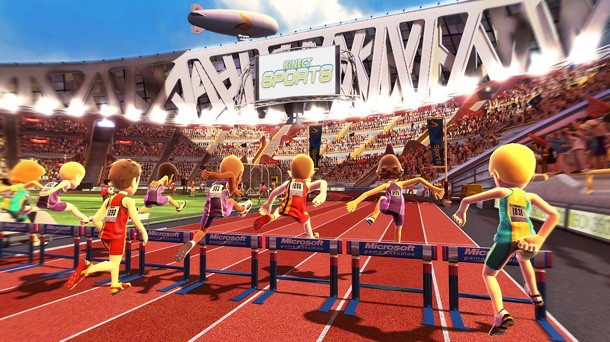Please support Game Informer. Print magazine subscriptions are less than $2 per issue
Kinect: Put The Controller Down

Nintendo took a chance by offering motion controls to the mainstream, giving people who might otherwise be intimidated by loads of buttons an intuitive alternative. Instead of fumbling with a controller, gamers could play tennis by swinging the remote or roll their ball down the alley by making the motion with the controller.
Nintendo’s gamble paid off in a big way, and it was only a matter of time before rivals Sony and Microsoft made their play at the same newly invigorated market. Sony took a fairly traditional strategy with Move, marrying motion controls with an LED that gives the system a better sense of positional space. Microsoft’s Kinect went in the opposite direction, boiling Nintendo’s philosophy down to its essence. Why use a controller at all? Why not just use your body to play games?
That approach invited plenty of skepticism. Would it work as promised? How accurate could it really be? Would the games be any good? We’ve spent a considerable amount of time with the Kinect hardware and a wide array of launch titles, and we can say that while it’s far from perfect, Microsoft’s device opens up some interesting opportunities.

Getting Kinected
“I think four million is underselling it a bit,” says Kudo Tsunoda, smiling slightly. He’s talking about an analyst’s recent proclamation that Microsoft’s Kinect will sell four million units over the fourth quarter of 2010 alone. As general manager of Microsoft Game Studios, Tsunoda definitely has a dog in that fight. Tsunoda has also taken on the role of Kinect’s public ambassador, showing it off at its E3 debut back when it was called Project Natal, and popping up on Jimmy Fallon’s show to play Kinect Adventures with Miranda Cosgrove.
So yeah, Tsunoda is a little hyped on Kinect.
“It’s not only the first batch that’s going to sell,” he continues. “As more and more people get it, it kind of has an avalanche effect. I think four million is a nice number to put out there, but I really believe we’re going to be able to do a lot more than that.”
It’s easy to get excited about Kinect when you’re on its payroll, but what about the rest of us?

Kinect’s technology and business plans invite a healthy dose of skepticism. First up, there’s the price. If you want to get into Kinect gaming, you have one of two options. The device and a pack-in game, Kinect Adventures, retails for $149. The console bundle sells for $299, which includes Kinect, Kinect Adventures, and an Xbox 360 S with 4GB of storage space. Tsunoda is quick to defend the cost, saying that after players spring for that initial price, they’re done. Unlike other devices, such as Move or the Wii, players don’t have to pay for additional controllers if they want to play multiplayer games with their friends.
Price is also connected to the next major Kinect question: Are the games any good? Specifically, are the games good enough to warrant that $150 investment? Before we get too far, let’s step back and get a refresher course on Kinect.
Kinect combines a variety of separate technologies into a single package. The device bathes the immediate area in invisible infrared light, which is then detected by a special camera. That camera works in conjunction with its partner – essentially a webcam – to differentiate a person from the background. Several microphones are housed in Kinect as well, enabling it to detect voice commands.
It’s already possible to play games that use cameras on the three major consoles; that’s nothing special. The real innovation comes in the software. Players can register themselves with the system through a quick succession of scans, after which the system will always recognize them. That opens up a range of possibilities, including the ability to log on a user on sight, pick their avatar when they join in a game, and more.
The microphones are arranged in such a way that they can detect a user’s position in a room. They also do a terrific job of ignoring background noises. I’ve been able to flawlessly direct a movie to stop, pause, and fast forward by using my regular speaking voice – without any kind of previous calibration – on an extremely busy show floor.

Outside Interference
Back to the games. One of the most interesting things about Kinect is how it determines which person in a room is the player and ignores everyone else. As I was playing Kinectimals, for instance, I was petting an imaginary tiger cub and a photographer walked over, crouched, and took a photo of my hands from about a foot away. While I thought that was odd, the game didn’t seem to mind at all. The action didn’t hiccup or stutter from the interloper’s actions.
As I’ve noticed throughout the various games I’ve played, that amount of “focus” is entirely up to developers. With Dance Central for example, ignoring everyone else in the room would be detrimental to the experience. Tsunoda says those kinds of calls are made by developers on a game by game basis. “We try not to limit how developers use the technology, because games will use them in different ways,” he says. “You’ll see a game like Dance Central that uses a lot of the people in the background as part of the dance routine, and you don’t want to limit things like that.”
That’s a healthy philosophy to have, but some developers are still struggling with the technology. In several cases, people standing off to the side of a game accidentally interfered with the action just by being present, causing characters to suddenly veer off in the wrong direction or preventing access to menus and other critical areas. In all of these cases I’ve seen, having the offending player move out of view seemed to do the trick. Seeing it done extraordinarily well, as with Kinectimals, made it more noticeable when other games didn’t manage background interference as well. These games were all works in progress, but demonstrated that developers had better make sure their quality assurance teams know what they’re doing with Kinect games.

Two Kinds Of Motion
Kinect’s launch titles fall into two main camps. In one, games faithfully represent player actions from Kinect. Your Shape Fitness’ yoga class is an excellent example of this style of gaming. “In yoga, it makes total sense because you’re doing the exact yoga motions and you want those poses to be correct,” says Tsunoda. “A big part of that experience is actually training to learn how to do yoga properly, so you want an exact matching 1 to 1. But something in Adventures, where you’re jumping over stuff, do you really want it to where it’s only how high you can jump? That really limits the fun experiences you can have with the game.”
That’s probably the source of some of the criticisms that Kinect games feel odd or floaty. Unlike traditional games, where you press a button and things happen instantaneously, Kinect is interpreting your actions visually and then translating them into a game. As of now lag is inherent to that action, but much of that delay is probably your own body’s fault. Many of us are accustomed to pressing buttons, because we do it so often. When it comes time to jump, though, we’re not always so spry.
Jumping is a common interaction among the games in Kinect’s launch lineup, and I couldn’t help but notice that they all share a common setup: before players have to jump, there’s some kind of colored line, shaded zone, or other similar detail before the required leap to get players ready. After failing a few times in Kinect Adventures, I got the timing down. That translated immediately to the jumps in Sonic Free Riders and the leaping sections in Kinectimals’ obstacle courses, where I did much better.
“People don’t really know how high they jump,” says Tsunoda. “If I jump in the air, is it four inches? Is it 16? What people know is when they take off and when they land. It’s really important to feel in control of the character. If they break it too much, then it starts feeling disjointed from what they’re doing.”
Some early reports said Kinect would only work if players stood up. That’s simply not true, Tsunoda says. He cites Kinectimals, which lets players teach their adopted cubs to play dead by laying on the ground. “Whether it’s standing, whether it’s sitting, whether it’s laying down, whether it’s jumping, it’s all things Kinect can do, and then it’s just allowing developers to do what makes the most sense,” Tsunoda says. “Obviously, you’re not going to be doing something like Kinect Sports, where you’re playing football, you’re not going to be doing it sitting on the sofa – that doesn’t make much sense. But certainly you don’t want to be playing movies and have to stand up to fast forward.”
Tsunoda works at one of the most connected companies on the planet, so you probably won’t mistake him for a luddite. Still, as I get ready to leave, he says that a lot of technology has been bothering him recently. “It’s somewhat disappointing to me to see all of the technological innovations that have been made recently, whether it’s social media or mobile stuff. So much of the technology now is about dividing people up rather than bringing them together. You go to a party and everybody is standing around tapping at their phones. Or with social media, instead of just sharing experiences I’ve had with you, I post them up to the web somewhere and you download them from there and then put your experiences up. One of the reasons it’s called Kinect is that we’re really focused on developing genuine human to human interactions and being able to bring people together for shared memories and shared experiences.”
It’s clear Tsunoda’s ambitions extend far beyond merely selling four, six, or 10 million units. While we’ll have to wait and see how it ultimately pans out, Kinect is full of wonderful possibilities.










